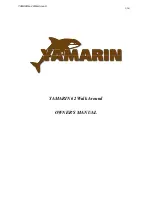
22
•
After coming on plane, raise the trim to a point where the engine is level with or slightly above the
plane of the water. This is usually with the bow at about 3
o
to 5
o
above level. This will provide the
smoothest, most economical operation.
•
Keep a constant vigil for other boats and watercraft and be prepared to give way, or slow down, if
necessary. (We suggest you enroll in a boating safety course offered by the U.S. Power Squadron or
the Coast Guard Auxiliary.)
•
When coming off plane, allow the engine to come back to an idle speed until the boat slows down.
•
Shift to the neutral position.
Never allow anyone to sit on the gunwale while the boat is moving!
While underway keep a constant vigil for other craft that may be approaching, the gauges on your boat,
location of passengers and the general sound and feel of your craft. Often, a change in the way the
engine sounds or the boat feels will presage a problem. Your early attention may prevent a more
serious problem.
If you should strike an underwater object, bring the throttle to neutral and stop the engine.
Inspect the lower unit for damage. If none is apparent, proceed as before but heighten
your awareness of the engine and its operation to make sure a problem has not gone
undetected.
9.4 Towing or Being Towed
Sooner or later your will have the misfortune of having to be towed in or needing to tow someone back
to a safe landing. It is important that this be done properly so that a difficult situation does not
become worse. This comes under a longstanding, unwritten law of the sea that one boater will aid
another in time of distress. The 1971 Boating Safety Act grants protection to those assisting others at
sea as ”Good Samaritans” and absolves them of civil liability rising from the aid being provided.
When being towed, it is best to have a line passed from the tow boat to the one being towed, assuming
the towing boat has a line of adequate size and length. The tow boat should also tow the disabled
vessel from as close to amidships as possible. This reduces the tendency to yaw. If
possible, the towing boat should use a bridle attached to the two stern ski tow eyes.
The vessel being towed should attach the tow line to the bow eye that holds the boat
onto the trailer. This provides an optimal tow position and a strong tow point. Have
the occupants of the boat being towed sit aft of amidships, but not all in the stern.
Attention should be given so the boat remains balanced and on an even keel. Some
boats tow better with the engine tilted out of the water, others need the engine to act
as a rudder to be able to maintain a straight line. Start with the engine tilted. If that
does not work well lower the engine until it is about perpendicular.
You should never attempt to plane off the boat being towed.
9.5 Stopping the Boat
Gradually bring the controls back to the low forward position and allow the boat to gradually slow
down. After the boat has dropped into the displacement mode, shift to the neutral position. If you have
been running the boat hard for some time, allow the engine to idle for several minutes to gradually cool
Summary of Contents for 185CC
Page 1: ...Owner s Manual 185DC REVISED 6 22 05...
Page 29: ...29 Appendix 185DC...
Page 30: ...30...
Page 31: ...31 z Hydraulic Steering System...
Page 32: ...32...
Page 33: ...33...
Page 34: ...34...













































